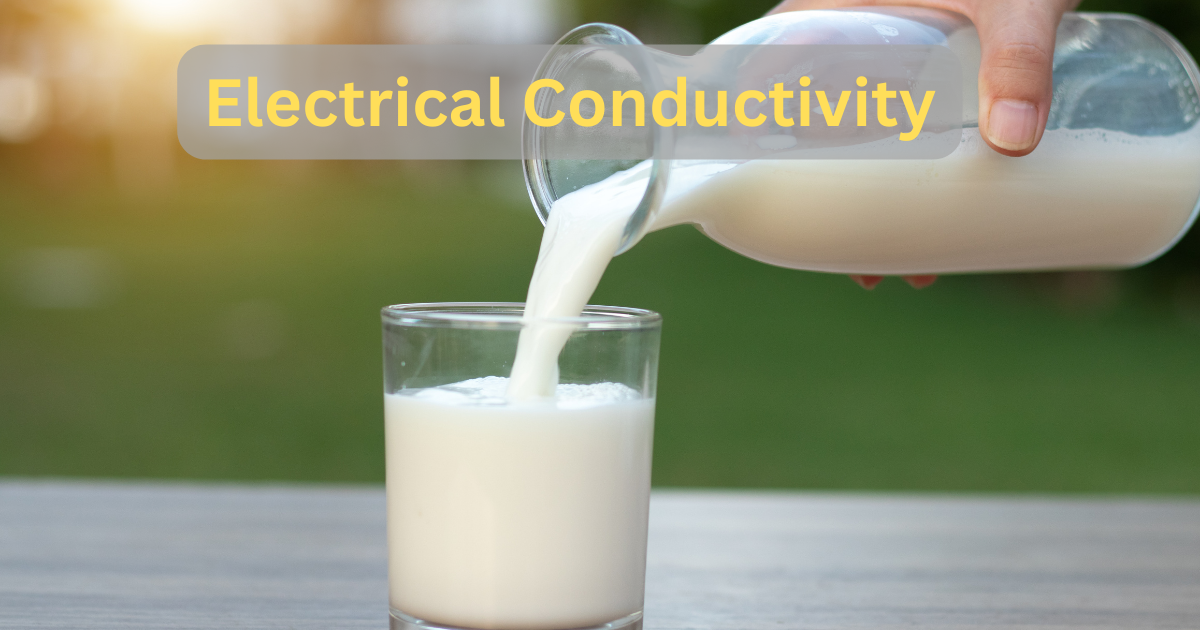Electrical Conductivity
Electrical Conductivity is considered as a possible index of mastitis, added water, added neutralizers, and as a means of controlling solids concentration and composition in dairy processing. The specific conductance of milk reflects its concentration and activity of ions and is of the order of 5mS/cm @ 25 degree C (4.0-5.5mS/cm). Digital EC meters give instantaneous results. Pocket devices for field applicability are also available.
Procedure:
1. To measure the electrical conductivity of milk, the following equipment and materials are needed:
- Milk: Obtain a fresh sample of milk for testing purposes.
- Conductivity meter or digital multimeter: This device is used to measure the electrical conductivity of the milk. Make sure it has a specific mode for conductivity measurement.
- Electrodes: Made of stainless steel or platinum. The electrodes play a crucial role in facilitating the flow of electrical current through the milk sample.
- Container: Select a suitable container or beaker to hold the milk sample during measurement.
- Distilled water: This is required for calibration purposes.
2. Calibrate the conductivity meter: Calibration is essential to ensure accurate measurements. Follow the manufacturer’s instructions to calibrate the conductivity meter using distilled water. Calibration compensates for variations or drifts in the meter’s readings, ensuring reliable results.
3. Prepare the milk sample: Take a fresh sample of milk that is representative of what you want to measure. If the milk has been stored in a refrigerator, allow it to reach room temperature. This step helps ensure consistent results as temperature can affect the electrical conductivity of the milk. Give the milk a gentle stir to distribute any fat or solid particles evenly throughout the sample.
4. Clean and prepare the electrodes: Proper electrode preparation is crucial for accurate measurements. Start by cleaning the electrodes with distilled water to remove any contaminants or residues from previous use. Make sure the electrodes are dry before proceeding. Inspect the electrode surfaces for any signs of damage or corrosion, as this can impact the accuracy of the measurements. If needed, gently polish the electrode surfaces using a soft cloth to remove any impurities.
5. Set up the measurement system: Insert the prepared electrode into the milk sample. Ensure that electrode is immersed sufficiently in the milk to cover the measurement area. However, be cautious not to allow the electrode to touch the sides or bottom of the container, as this can introduce measurement errors.
6. Take the measurement: Turn on the conductivity meter or digital multimeter and select the appropriate mode for measuring electrical conductivity. Allow the measurement to stabilize for a few seconds to obtain accurate readings. The meter will display the electrical conductivity value of the milk sample in units such as Siemens per meter (S/m) or millisiemens per centimeter (mS/cm). This value represents the ability of the milk to conduct an electrical current.
7. Record the measurement: Note down the electrical conductivity value displayed on the meter. It’s important to record this value for further analysis or comparison.
8. Clean the electrodes: After completing the measurement, remove the electrode from the milk sample. Rinse it thoroughly with distilled water to remove any traces of milk or residue. Wipe the electrode dry with a clean cloth before storing it for future use.
9. Repeat the process if necessary: If you need to measure the electrical conductivity of multiple milk samples, repeat steps 3 to 8 for each sample. It is crucial to clean the electrodes and calibrate the meter before measuring each new sample to ensure accurate and reliable results.
10. Analyze the results: Once you have obtained the electrical conductivity values for your milk samples, you can analyze the data as per your requirements. Compare the values with reference ranges, previous measurements, or established standards to assess the quality or composition of the milk. Electrical conductivity can be influenced by factors such as temperature, fat content, protein content, and overall milk composition, so it’s essential to consider these factors when interpreting the results.
Remember to consult the specific instructions provided by the manufacturer of your conductivity meter or digital multimeter, as the procedure may have slight variations depending on the equipment being used.

1 thought on “How to measure Electrical Conductivity of Milk Sample”